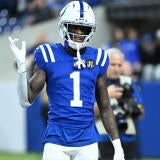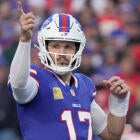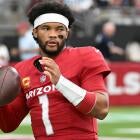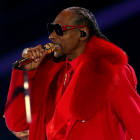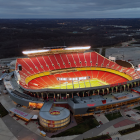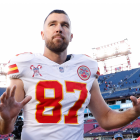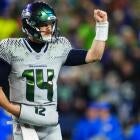Agent's Take: Broncos' return to Super Bowl contention starts with fixing the offense
John Elway did a wondrous job building an elite defense, and now it's time to do the same on offense

Denver's five-year stranglehold on the AFC West has come to an end. Not only will they fail to win the division, but the Broncos are the first team to miss the playoffs after winning the Super Bowl since the 2013 Ravens. It's also the first time the Broncos won't be a playoff participant during John Elway's tenure as a front office executive, which began in 2011.
Elway hasn't stood by idly when the season ends in disappointing fashion. A lopsided defeat in Super Bowl XLVIII where the Broncos were physically manhandled by the Seahawks prompted the general manager and executive vice president of football operations to reconfigure his roster despite having one of the most prolific offenses in NFL history.
Improving the defense was the top priority. Cornerback Aqib Talib, safety T.J. Ward and defensive end/outside linebacker DeMarcus Ware were signed during the first 24 hours of free agency in 2014. Elway replaced John Fox as head coach with his former backup Gary Kubiak despite a 49-22 overall record after being upset by the Colts in the 2014 season's divisional playoffs.
The transformation from an offensive juggernaut to a defensive powerhouse led to a victory in Super Bowl 50. Since the pendulum seems to have swung too far in the other direction, expect Elway to be aggressive during the offseason in attempt to create a more balanced team.
Here's a preview of what lies ahead for the Broncos.
How a quarterback quandary was born
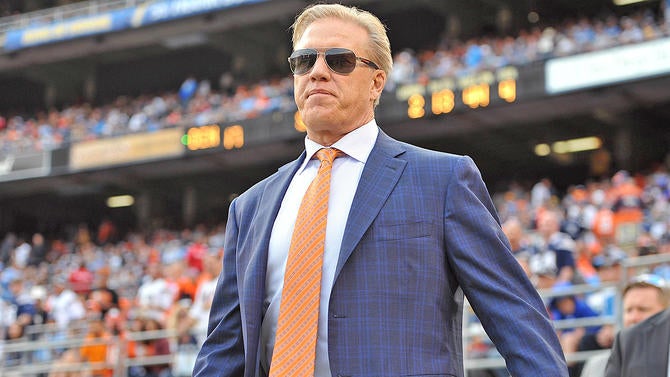
Elway was caught off guard when Brock Osweiler left in free agency for the Texans on a four-year, $72 million contract containing $37 million in guaranteed money. Osweiler, a second-round pick for the Broncos in 2012, was Elway's handpicked successor to the retiring Peyton Manning. It may have worked out for the best that he couldn't retain Osweiler, who was recently benched for ineffectiveness.
Elway had discussions with the 49ers prior to the NFL Draft about acquiring a disgruntled Colin Kaepernick. The quarterback's unwillingness to take a significant pay cut prevented the trade from happening.
Elway then turned his attention to the draft to find a quarterback once talks over Kaepernick stalled. A third-round pick was given to the Seahawks in order to swap first-round picks so Paxton Lynch could be taken 26th overall.
Trevor Siemian, a seventh-round pick in 2015, won an open competition to become Denver's starting quarterback almost by default because of Lynch's steep learning curve to get up to speed for the NFL. Siemian has been serviceable in what is essentially his rookie year, since he hadn't thrown a pass in an NFL regular-season game before this year's opener. Lynch has also started two games in place of Siemian because of shoulder and foot injuries.
Who will start in 2017?
There's been plenty of speculation that Denver's 2017 starting quarterback isn't currently on the roster. A veteran quarterback will only be brought in if Elway thinks two things: that Siemian didn't show enough potential this season, and that Lynch is still considered a major work in progress.
Denver could have intriguing options should Elway go the veteran route. A divorce between Tony Romo and the Cowboys seems inevitable because of rookie sensation Dak Prescott. Romo would prefer Dallas to release him, leaving the veteran free to choose his destination.
A trade seems more likely, unless Dallas' compensation demands are deemed too excessive by interested teams. It's hard to imagine any team giving up a more than a mid-round pick for a quarterback with an injury history who will be 37 years old next season.
The type of compensation the Packers received from the Jets in 2008 for a soon-to-be 39-year old Brett Favre could be used as a guide with Romo. Favre was dealt for a conditional fourth-round pick that had the potential to become as much as a first-round pick depending on the Jets and Favre's performance in 2008. It was ultimately a 2009 third-round draft choice. Unlike Romo, who hasn't played at all in this regular season, Favre led the Packers to the NFC Championship Game while being named an All-Pro in the season prior to his trade.

Romo is scheduled to make $14 million in 2017, $19.5 million in 2018 and $20.5 million in 2019. All of Romo's remaining salaries are not guaranteed. $14 million for a starting quarterback next season is a pretty reasonable amount considering the average yearly salary for starting quarterbacks this season, including those on rookie contracts, is approximately $14.7 million, according to NFLPA data.
Fortunately for Denver, their current financial investment at quarterback is extremely modest. Siemian is making $615,000 on a $628,196 salary cap number next season. Lynch's 2017 salary cap number is a little above $2.15 million.
Romo would be an attempt to replicate the success Denver just experienced with Manning, another older quarterback that had an injury history, particularly if Romo can perform like he did in 2014 when he was last healthy. Romo was a second-team All-Pro in 2014 when he led the NFL with a 113.2 passing rating and 69.9 completion percentage. He would be less of a health risk than Manning was in 2012 after the now-retired quarterback missed the 2011 season because of multiple neck surgeries.
Broncos defensive coordinator Wade Phillips has a history with Romo. He was Romo's head coach in Dallas for three-and-a-half seasons from 2007-10. Romo may have also made a lasting impression on Elway in 2013 when he almost singlehandedly defeated a Broncos team headed to the Super Bowl. He threw for 506 yards in a 51-48 loss.
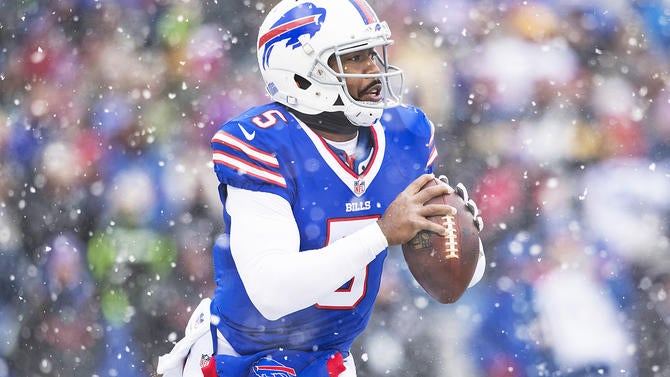
Buffalo benching Tyrod Taylor for the season finale suggests that the option on his contract for an additional five years at $82.5 million (worth up to $101.75 million through salary escalators and incentives) won't be picked up.
Denver has had interest in Taylor the last two offseasons. Head coach Gary Kubiak was Taylor's offensive coordinator in 2014 during his lone season on Baltimore's coaching staff. Taylor chose Buffalo over Denver as a free agent in 2015 despite the Broncos offering him more money because of a better opportunity to play immediately with the Bills.
Denver inquired with Buffalo about Taylor's availability via trade before this year's draft and preseason contract extension. Assuming Buffalo lets Taylor go, he will be looking to find a deal from another team similar to the option declined by the Bills.
A much cheaper veteran option, which would likely mean a three way battle for the quarterback job, would be someone like Brian Hoyer. He had played well enough replacing an injured Jay Culter in Chicago that he was likely to remain the starter before being sidelined for the season in late October with a broken left arm. Hoyer is making $2 million this season in his one-year deal with Bears.
Russell Okung's option and the offensive line
Regardless of who is Denver's starting quarterback in 2017, the offensive line must be addressed. In fact, it may be a bigger issue than who is under center next year. In Pro Football Focus' (PFF) latest composite offensive line rankings from about a month ago, Denver's was 25th. Only center Matt Paradis grades out above average.
The most immediate decision is with left tackle Russell Okung. He signed a "try it before you buy it" deal after tepid interest in free agency. It's a one-year deal for $5 million with $3 million of playing time incentives (which will be earned), while the Broncos have an option for an additional four years worth $48 million. The option must be picked up between the end of the playoffs and the start of free agency on March 9.
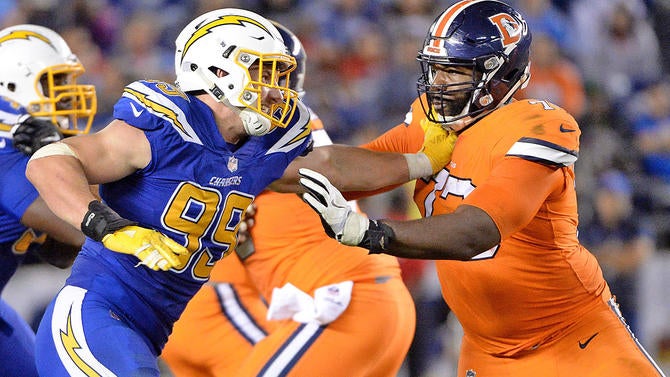
It may make sense for the Broncos and Okung, who represents himself, to reach a compromise on a long-term deal averaging much closer to the $8 million he is making this season, because he is unlikely to get a contract at comparable value to those option years on the open market again.
It could be appealing for Denver to have some stability at left tackle under the right circumstances ... because right tackle has been a disaster.
Donald Stephenson, who signed a three-year, $14 million deal in the offseason, is PFF's lowest-graded starting tackle. Ty Sambrailo, Stephenson's backup, hasn't been much better. Paradis, who is the only lineman who has played anywhere near a Pro Bowl level, is facing offseason hip surgery. Guards Max Garcia and Michael Schofield are just adequate.
Squeezing room out of the salary cap
NFL teams were informed at a league meeting in mid-December that the 2017 salary cap is projected to be between $166 million and $170 million. These projections are consistent with the eight percent annual growth of the salary cap in recent years.
During the offseason, only the top 51 cap numbers count on the salary cap. The Broncos have slightly over $136.3 million in 2017 cap commitments with 39 players under contract, while $7.4 million of unused cap room can be carried over from the 2016 league year. Once not-likely-to-be-earned incentives that were achieved, tenders for restricted free agents and exclusive rights players with expiring contracts, and futures contracts for practice squad players are accounted for, Denver should have approximately $25.5 million of 2017 cap space, assuming a $168 million salary cap.
Okung would be a big source of cap room if the Broncos decide to move on from him. He is currently counting $11.7 million on next year's salary cap. Declining the option would create $11.3 million of cap space (which includes a $200,000 credit for proration of his $1 million option bonus counting against this year's cap). A new long-term deal at a lower rate could generate anywhere between $3 million and $5 million of cap room, depending on the structure.
Releasing Stephenson before his $4 million base salary for 2017 becomes fully guaranteed on March 13, the fifth day of the league year, seems like a certainty. Denver would pick up $3 million of cap space by getting rid of him.
Tight end Virgil Green doesn't give Denver much in the passing game. Paying him $2.8 million to essentially be a blocker could be hard to justify. That's also the amount of cap room that would be gained by letting him go.
Addressing team needs in free agency
The Broncos have eight unrestricted free agents, including Ware, defensive end Vance Walker, cornerback Kayvon Webster and defensive tackle Sylvester Williams. Inside linebacker Todd Davis and kicker Brandon McManus are restricted free agents. Although both were undrafted free agents, each seems likely to receive the lowest restricted free agent tender at around $1.8 million, which would only entitle Denver to match another team's offer sheet.
Denver doesn't have a lot players entering free agency because inside linebacker Brandon Marshall, wide receiver Emmanuel Sanders and safety Darian Stewart received new contracts ahead of schedule.
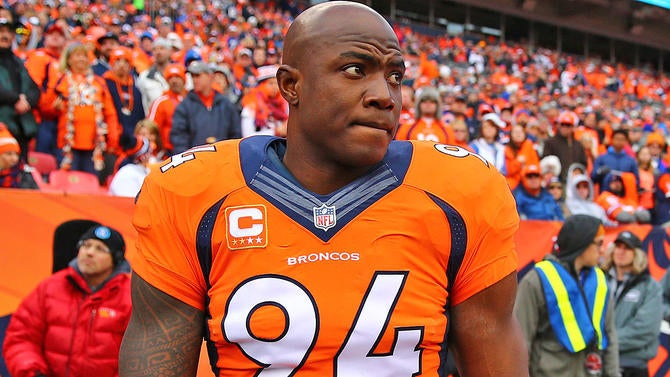
None of the unrestricted free agents are indispensable. The Broncos may not make an attempt to re-sign Ware because of 2015 first-round pick Shane Ray's development and reserve linebacker Shaquil Barrett becoming more than just a pass rusher. The nine-time Pro Bowler hasn't been able to stay healthy either. Ware, 34, has missed 11 games over the last two seasons because of back issues and a fractured forearm.
Potentially having upwards of $40 million in cap space would give the Broncos plenty of flexibility to address their offensive needs, including a veteran quarterback, just as they did with the defense in a 2014 free agency spending spree.
Riley Reiff (Lions), Mike Remmers (Panthers), Ricky Wagner (Ravens) and Menelik Watson (Raiders) should be the best right tackles on the open market. Since right tackle compensation lags behind the other offensive line positions, the top of the market is less than $7 million with less than $15 million in guarantees.
There are plenty of options at guard, with T.J. Lang (Packers), Ronald Leary (Cowboys), Larry Warford (Lions), Chance Warmack (Titans) and Kevin Zeitler (Bengals) scheduled to be unrestricted free agents. Aside from Kelechi Osemele and his monster deal, the best available guards were commanding $7 million to $8 million per year with $15 million to $20 million in guarantees during the 2016 offseason. This price has surely gone up with David DeCastro and Kyle Long receiving extensions worth $10 million per year in the preseason from the Steelers and Bears, respectively.
The Broncos haven't had a dynamic pass catching tight end since Julius Thomas left for Jacksonville in free agency last year. Dealing for Vernon Davis and A.J. Derby in each of the last two seasons as the trading deadline approached hasn't panned out.
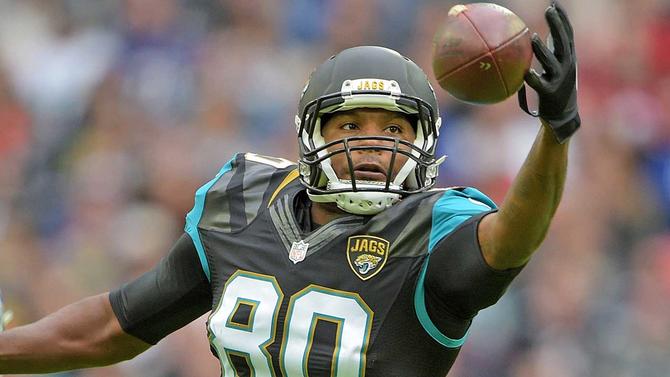
Thomas could be a salary cap casualty after two injury plagued seasons with the Jaguars. His return should be investigated if he's available, since it won't be a strong free agent tight end class. Martellus Bennett conceivably could become the league's highest-paid tight end at over $10 million per year if the Patriots don't franchise him. Jordan Cameron (Dolphins), who has concussion issues, and Jared Cook (Packers) would be among the best available.
An improved offensive line and a healthy C.J. Anderson should boost the running game. The Broncos had major difficulties moving the ball on the ground after Anderson was lost for the season in late October with a torn meniscus in his right knee.
Changes to the offensive coaching staff may also be in order. Rick Dennison should be relieved of his coordinator duties and given the option to return to concentrating on his area of expertise, coaching the offensive line, or allowed to go elsewhere. It may be time for Kubiak to bring in a creative offensive mind from outside the organization since the Broncos have had trouble consistently scoring points during his tenure as head coach.
The interior of the defense must be addressed, as losing defensive lineman Malik Jackson and inside linebacker Danny Trevathan to free agency has been felt. The Broncos had the NFL's third-best defense against the run in 2015, giving up 83.6 yards per game. It's gone up to 135.2 yards per game this season, which ranks 29th.
Brandon Williams should be the premier run-stuffing interior defensive lineman available, as the Ravens have had a hard time keeping players that hit open the market. Defensive tackle Damon Harrison, who has done wonders for the Giants' run defense this season, signed a five-year, $46.25 million deal with $24 million of guarantees as a free agent in March.
A let the buyer beware option could Jets defensive lineman Sheldon Richardson. The Broncos kicked the tires on the 2013 Defensive Rookie of the Year at the trading deadline. Nothing came to fruition because the Jets reportedly wanted a first-round pick in return for Richardson. Besides having well-documented off-the-field problems, the immensely talented Richardson's lack of professionalism where his effort and desire have been questioned likely has diminished his trade value.
Richardson will be playing 2017, which is a contract year, on a $8.069-million fifth-year option.
Is the arrow pointing up or down in Denver?
Denver probably isn't going to start another multi-year reign as AFC West champs next season, even with offensive upgrades in free agency and the draft. The AFC West is too competitive now.
The Raiders, who have earned their first playoff berth since the 2002 season, appear to be positioned to be the class of the division for the foreseeable future with improving young talents such as quarterback Derek Carr, wide receiver Amari Cooper and edge rusher Khalil Mack. The Chiefs also have a good nucleus intact. Although the Chargers are 5-10, they would have a better record without several late-game collapses early in the season and a rash of injuries.
The Broncos should continue to be playoff contenders because of Elway's willingness to retool the roster when necessary. Once a team gets in the postseason, even as a wild card, a championship is within reach.

